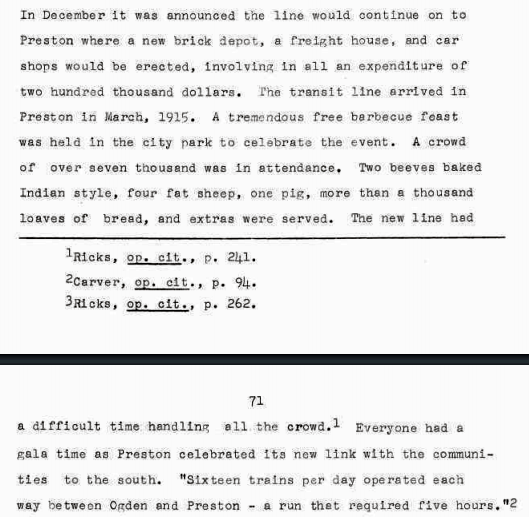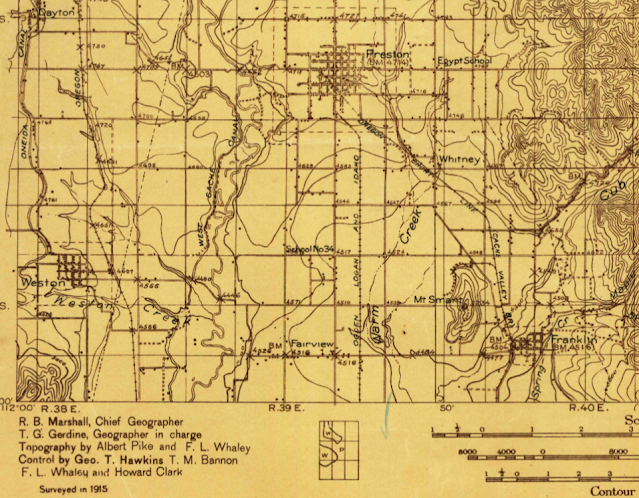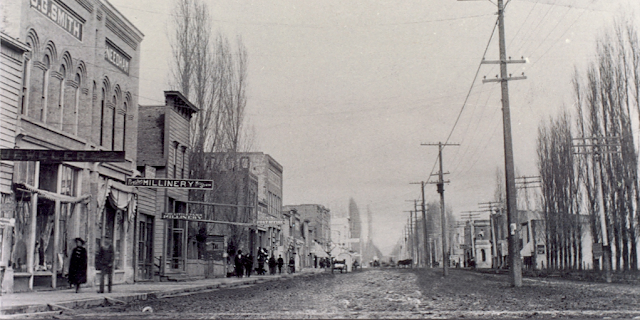
We have been unable to find a photo of the interurban in Preston. This picture was taken in July 1915 when the first interurban arrived in Orem, Utah. We believe the interurban cars shown here are a reasonable facsimile of those that would have been in use in Preston at the same time.
https://collections.lib.utah.edu/ark:/87278/s6r78pnk
https://digital.lib.usu.edu/digital/collection/Bear/id/32426/rec/93
https://www.cachecounty.org/assets/department/devserv/zCWP/September%202019%20(1.2).pdf
For a fascinating history of the Utah Interurban Company see:
https://issuu.com/utah10/docs/uhq_volume27_1959_number2/s/97326
Prior to the arrival of the interurban, Preston was a typical rural western city with unpaved streets that often became a mud bog in wet weather. Travel to nearby communities was a time-consuming and often tedious journey. The interurban changed all that by connecting Preston with a new world of opportunities.
http://www.franklincountyhist.org/When Ogden, Logan and Idaho Railways Company officials announced in December 1914 they were going to extend the line to Preston it was Big News throughout the area.
https://www.newspapers.com/clip/62010237/december-1914-preston-announcement/"Ollie", as the Ogden, Logan and Idaho Railway was known, didn't waste any time in following through on their promise. The line reached Preston in March 1915. Since Wasatch area March weather isn't conducive to large outdoor public events, Preston People and Ollie officials wisely waited until mid-April to celebrate the interurban's arrival in Preston.
https://www.newspapers.com/clip/61955581/official-opening-april-17-1915/The interurban celebration attendance remains one of the largest single-day events in Preston history. Only "That Famous Preston Night Rodeo" has been able to top the April 1915 celebration attendance.
(Editor's Note: The screen clip above is from a BYU Master's Thesis linked below. The thesis author quoted from the "Franklin County Citizen", April 22 1915 for the account of the celebration.)
(Editor's Note: The screen clip above is from a BYU Master's Thesis linked below. The thesis author quoted from the "Franklin County Citizen", April 22 1915 for the account of the celebration.)
"A History of Preston, Idaho"
by Clarence G. Judy, 1961
Brigham Young University - Provo
Pages 70-71 (78-79 on PDF viewer)
Ollie constructed an entirely new railway to reach Preston. It was completely separate from the older, nearby Cache Valley RR of the Oregon Short Line Railroad. The line approached Preston in a piano-wire-straight due-north directione before curving northwest to intersect South State Street.
https://ngmdb.usgs.gov/topoview/viewer/This 1915 USGS topo map clip shows how the interurban intersected South State Street and then turned north to its terminus at Oneida and State in downtown Preston.
https://ngmdb.usgs.gov/topoview/viewer/Just to be on the safe side, we studied USGS topographical map symbols to verify that the interurban did indeed extend north on State Street to its intersection with Oneida.
1918 Map key
Page 223
By deriving GPS coordinates from the 1915 USGS topo map, we were able to determine the extent of the interurban's line in Preston.
https://bit.ly/3ouv1fUUsing additional GPS coordinates derived from the 1915 USGS topo map, we found the interurban's alignment out in the farmland adjacent to Preston. In some places, the old line is still clearly visible on Google Earth's imagery. We're confident that our own red lines drawn in here are within a few feet of where the interurban line actually existed and intersected with South State Street.
Image courtesy of Google Maps.Travel on the interurban line from Preston to Ogden supposedly took five hours, presumably because of many stops in between and the slower speed of the interurban. Ogden had trolley lines long before the interurban reach Preston. Eventually the lines along Washington Avenue became an interurban backbone. (Editor's Note: the source of the above view is linked below. You can find many early views of "Ogden Washington Avenue" but simply using that search term without quotes on eBay."
https://www.ebay.com/itm/Postcard-Post-Card-Ogden-Utah-Ut-Washington-Avenue-2/303743269871Ridership statistics for the Preston stretch of Ollie have yet to be found. The above figures are from a completely different interurban along the Wasatch Front. Clearly, the interurban was very popular in its heyday.
We found online this share certificate for Ollie. Ironically, the antique certificate sold for $1000, the same value for which it was issued long ago.
https://www.glabarre.com/category/Railroad_Bonds/c30d5p6Occasionally, some Ollie artifacts turn up online.
https://picclick.com/Ogden-Logan-Idaho-Railway-Company-1916-Railroad-173435357136.htmlAs far as we can discern, the Ogden, Logan and Idaho Railway eventually became the Utah Interurban Company. Equipment was upgraded as better technology became available. Automobile usage eventually spelled the end of the interurban. The lines were all closed down and removed not long after the end of WWII.
Source of photo is Page 2https://www.cachecounty.org/assets/department/devserv/zCWP/September%202019%20(1.2).pdf
For a fascinating history of the Utah Interurban Company see:
https://issuu.com/utah10/docs/uhq_volume27_1959_number2/s/97326




















































